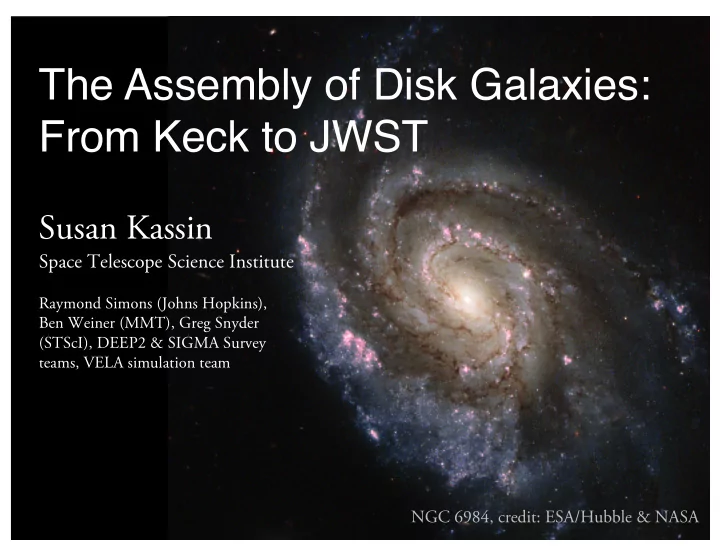

The Assembly of Disk Galaxies: From Keck to JWST Susan Kassin Space Telescope Science Institute Raymond Simons (Johns Hopkins), Ben Weiner (MMT), Greg Snyder (STScI), DEEP2 & SIGMA Survey teams, VELA simulation team NGC 6984, credit: ESA/Hubble & NASA
Raymond Simons 6 th year graduate student at Johns Hopkins University • SIGMA survey of galaxy kinematics at z=2 • Mock observations of galaxy simulations
When/how are disks assembled? When/how do disks settle into their current well- ordered state? M63, credit: HubbleSite.org
Measurements of the kinematics of high z galaxies σ V ro t ACS + WFC3 H α : MOSFIRE V rot and σ are measured from emission lines in Keck spectra It is important to take into account the effects of seeing and beam smearing when measuring galaxy kinematics. Weiner et al. 2006a,b; Kassin et al. 2007,12; Covington, Kassin et al. 2010; Simons, Kassin et al. 2016
Measurements of the kinematics of high z galaxies tell us about their physical state s dominated mixed V rot dominated z~1 HST V rot sini = 208 km/s 75 km/s 29 km/s s gas = 40 km/s 55 km/s 59 km/s σ is a gas velocity dispersion • integrates over all velocity gradients beneath the seeing • quantifies the amount of disordered motions in galaxies (Weiner et al. 06, Kassin et al. 2007, Covington, Kassin et al. 2010, Kassin et al. 14) • Does not indicate a “thick disk” (i.e., a disk that is simply puffier)
Stellar Mass Tully-Fisher Relation to z=1.2 coincident with Faber-Jackson 2 + σ gas 2 S 0.5 = 0.5 V rot S 0.5 takes into account all the motions, not just rotation. S 0.52 ~ total mass (see also Covington et al. 2010) Kassin et al. 2007,12
Ordered disks lie on ridge-line, Disturbed galaxies lie off
“Mass of Disk Formation” "Local" Tully-Fisher (z~0.2) disk will form disk may not form Simons, Kassin et al. 2015 et al.; see also Bloom et al. 2017
High-z Galaxies are Mostly Peculiars Still, more Ordered disks lie on ridge-line & more Disturbed galaxies lie off
Does the relative importance of V rot and σ evolve with time?
10 10 – 10 11 M ¤ σ V rot 10 9 – 10 10 M ¤ (km/s) (km/s) Redshift Redshift log σ = -0.84 (1+ z) -1 + 2.04 "Disk Settling" Kassin et al.12 Simons, Kassin et al. 2016 & 17 σ trend see also Wisnioski et al. 15, Turner et al. 2017
Linking galaxy populations in time with "abundance matching" (our best shot, but far from perfect) 10 10.7 – 10 11.7 M ¤ – 10 10.7 M ¤ 10 10 – 10 10 M ¤ 10 9
σ V rot (km/s) (km/s) 10 10.7 – 10 11.7 M ¤ 10 10.0 – 10 10.7 M ¤ 10 9.0 – 10 10.0 M ¤ Redshift Redshift "Disk Settling" Abundance matched galaxy populations (Moster et al. 2013) Kassin et al. 2012 Simons, Kassin et al. 2017
V rot / σ ~ 10 • local massive disks like the one shown How does the fraction of disk galaxies evolve? V rot / σ > 3 • analog of local low mass disks V rot / σ > 1 • rotation supported NGC 4388, credit: ESA/Hubble & NASA
“Disk Settling” Fraction of galaxies with V rot / σ >1 fraction increases with time of galaxies with 10 10 – 10 11 M ¤ V/ σ >1 10 9.5 – 10 10.5 M ¤ – 10 10 M ¤ 10 9 Redshift Kassin et al.12; Simons, Kassin et al. 2016 & 17
Large IFU surveys z ~ 3: • AMAZE/LSD: Gnerucci et of galaxy kinematics al. 2011 • KDS: Turner et al. 2017 z ~ 2: • KMOS 3D : e.g., Wisnioski et al. 2015 • SINS: e.g., Förster-Schreiber et al. 2006,9,11 SFR (M ¤ /yr ) z ~ 1: • MASSIV: e.g., Epinat et al. 2012 • KROSS: e.g., Madgis et al. 2016, Harrison et al. 2017 • KMOS 3D: e.g., Wisnioski et al. 2015 z<1 stellar mass (M ¤ ) • IMAGES: e.g., Flores et al. 2006, Yang et al. 2008, Puech et al. 2008
Quantitatively, surveys agree that disks fraction become more of ordered with galaxies with time 10 10 – 10 11 M ¤ V/ σ >1 10 9.5 – 10 10.5 M ¤ – 10 10 M ¤ 10 9 Redshift Kassin et al.12; Simons, Kassin et al. 2016 & 17
Only ~30% of Disk Settling high mass galaxies at Disk Assembly fraction z=2 have V/ σ of > 3! galaxies with 10 10 – 10 11 M ¤ V/ σ >3 10 9.5 – 10 10.5 M ¤ – 10 10 M ¤ 10 9 Redshift Kassin et al.12; Simons, Kassin et al. 2016 & 17
Mock V rot can be confused with orbital rotation of observations of mergers in ground- based observations a simulated merger galaxy => Fraction of disks at z~2 defined using V/ s is likely even lower VELA simulation (Ceverino et al. 2014, 16) Simons, Kassin, Snyder, Ceverino+ in prep
Conclusions: •the vast majority of galaxies at high redshift are not disks •galaxies increase in ordered Disk Settling rotation (V rot ) and decrease in disordered motions ( σ ) with Disk Assembly time fraction of •the average fraction of disk galaxies galaxies increases significantly with 10 10 – 10 11 M ¤ with time V/ σ >3 10 9.5 – 10 10.5 M ¤ – 10 10 M ¤ • higher mass galaxies arrive at 10 9 an ordered state first ("kinematic downsizing") Redshift • conclusions from high-z kinematic surveys depend on sample selections for mass and morphology
Recommend
More recommend